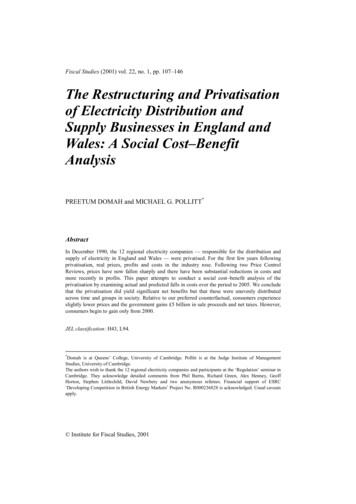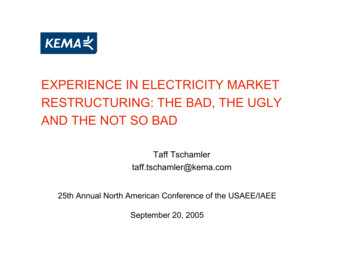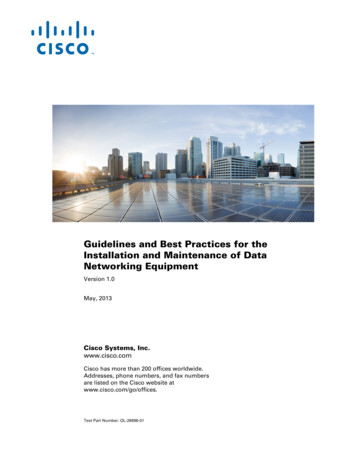
Transcription
Fiscal Studies (2001) vol. 22, no. 1, pp. 107–146The Restructuring and Privatisationof Electricity Distribution andSupply Businesses in England andWales: A Social Cost–BenefitAnalysisPREETUM DOMAH and MICHAEL G. POLLITT*AbstractIn December 1990, the 12 regional electricity companies — responsible for the distribution andsupply of electricity in England and Wales — were privatised. For the first few years followingprivatisation, real prices, profits and costs in the industry rose. Following two Price ControlReviews, prices have now fallen sharply and there have been substantial reductions in costs andmore recently in profits. This paper attempts to conduct a social cost–benefit analysis of theprivatisation by examining actual and predicted falls in costs over the period to 2005. We concludethat the privatisation did yield significant net benefits but that these were unevenly distributedacross time and groups in society. Relative to our preferred counterfactual, consumers experienceslightly lower prices and the government gains 5 billion in sale proceeds and net taxes. However,consumers begin to gain only from 2000.JEL classification: H43, L94.*Domah is at Queens’ College, University of Cambridge. Pollitt is at the Judge Institute of ManagementStudies, University of Cambridge.The authors wish to thank the 12 regional electricity companies and participants at the ‘Regulation’ seminar inCambridge. They acknowledge detailed comments from Phil Burns, Richard Green, Alex Henney, GeoffHorton, Stephen Littlechild, David Newbery and two anonymous referees. Financial support of ESRC‘Developing Competition in British Energy Markets’ Project No. R000236828 is acknowledged. Usual caveatsapply. Institute for Fiscal Studies, 2001
Fiscal StudiesI. INTRODUCTION1There have been major changes in the electricity supply industry since it wasradically restructured in 1990. These changes have included the growth ofcompetition in supply and generation, substantial improvements in efficiencyand reductions in prices, improvements in customer service standards andchanges in the ownership of many licensed electricity companies.The White Paper that announced privatisation (Secretary of State for Energy,1988) stated clearly that the main beneficiaries would be the consumers.Competition would ‘create downward pressures on costs and prices, and ensurethat the customer comes first’ (cited in MacKerron and Watson (1996, p. 186)).Our main objective is to find out whether consumers benefited from therestructuring and privatisation of the regional electricity companies (RECs) inEngland and Wales.We use the technique of social cost–benefit analysis (SCBA) as used inJones, Tandon and Vogelsang (1990) to study this question. Our studycomplements previous social cost–benefit analyses of the effect of restructuringand privatisation of the Scottish electricity supply industry (Pollitt, 1999), theelectricity supply industry in England and Wales (Green and McDaniel, 1998),Northern Ireland Electricity (Pollitt, 1997b) and the Central ElectricityGenerating Board (Newbery and Pollitt, 1997). It is also in line with other SCBAstudies such as Galal et al. (1994).This paper seeks to review the performance of the regulated supply anddistribution businesses of the RECs in the England and Wales electricity supplyindustry since privatisation and evaluates the gains (or losses) from restructuringand privatisation. It also assesses the distribution of these gains (or losses) toconsumers, producers and the government. A SCBA approach is used to achievethese objectives. The paper is in six sections. Section II briefly sets out thehistorical background. Section III details the theoretical arguments forliberalisation (restructuring and privatisation) and the social cost–benefitmethodology used. Section IV explains the data, Section V contains the resultsand Section VI concludes.II. HISTORICAL BACKGROUNDThe electricity supply industry was in public ownership from 1948 to 1990. InEngland and Wales, the Central Electricity Generating Board (CEGB) wasresponsible for generation and transmission; it sold electricity to 12 area boardsunder the terms of the bulk supply tariff, based upon its marginal costs. The areaboards were responsible for the distribution and supply to electricity consumers.1A glossary of terms is provided at the end of the paper.108
Electricity Distribution and SupplyDuring the course of 1982, the government’s ultimate intention to introducelegislation to allow private companies to set up to provide electricity toconsumers became clear (Electricity Consumers’ Council, 1982). The WhitePaper Privatising Electricity, in which the government laid out its plans for theindustry, was published in February 1988 (Secretary of State for Energy, 1988).Shortly prior to privatisation in 1990, 12 regional electricity companiesreplaced the 12 area boards. Transmission became the responsibility of theNational Grid Company (NGC), a company fully owned by the RECs.Distribution and supply were uncoupled to some extent, as a REC can supplyelectricity outside its franchise area on the payment of a charge for distributionover another REC’s network.Each REC owns and operates the electricity distribution network in itsauthorised area. The distribution systems consist of overhead lines, cables,switchgear, transformers, control systems and meters to enable the transfer ofelectricity from the transmission system to customers’ premises. Supplybusinesses are engaged in the bulk purchase of electricity and its sale tocustomers. Compared with the supply business of, basically, metering, billingand contract management, the distribution business is highly capital-intensive.The distribution of electricity is the most important business activity of theRECs and typically contributes the majority of their operating cash flow andprofits. In 1998, distribution and supply charges accounted for approximately 32per cent and 13 per cent respectively of a domestic customer’s bill, anddistribution has a significant influence on the overall quality of supply tocustomers. Analysing the impact of changes in ownership and the regulatoryframework makes economic sense owing to the potentially large influence thatelectricity distribution may have on final prices, and the distribution of gains orlosses from these changes.Electricity prices are regulated at different levels and stages.2 The initialdistribution price controls on the RECs were put in place by the government andexecuted by the Department of Energy at the time of restructuring, and permittedprice increases ranged up to 2.5 percentage points above the inflation rate(OFFER, 1994). Responsibility for future price controls was placed under anindependent regulatory body, initially called OFFER and latterly known asOfgem.3 The pattern of price falls in transmission, supply and generation is suchthat the share of distribution costs in final prices has risen since privatisation. Inthe earlier years, there had been public concern about profits and prices; later,more concerns were expressed with regard to increased dividends and the ability2The price controls since privatisation are summarised in Appendix A.OFFER (the Office of Electricity Regulation) started operation on 1 September 1989, five months after thefirst price controls on the RECs came into force. In response to changes, especially due to the fact that severalcompanies increasingly sold both gas and electricity to homes and businesses, Ofgem (the Office of Gas andElectricity Markets) was formed in 1999 by the merger of Ofgas (the former gas regulator) and OFFER.3109
Fiscal Studiesof distribution companies to finance share buy-backs4 and about the high pricesthat bidders have been willing to pay to acquire RECs.The initial price caps that were set by the Department of Energy wereconsidered by many to be somewhat ‘too’ generous to the companies. The mostimportant review was in August 1994, when OFFER announced reductionsaveraging 14 per cent in final electricity prices to take effect in April 1995,requiring cuts in real terms of 11–17 per cent in distribution charges in 1995–96and further reductions in real terms of between 10 and 13 per cent in 1996–97.Distribution charges were, thereafter, required to fall by 3 per cent per year inreal terms for the duration of the price control (until March 2000). These pricecontrols were then modified in 1998 to allow RECs to make certain additionalcharges for services to facilitate competition in supply. These distribution pricecontrols have been revised from 1 April 2000. Based on Ofgem’s predictions ofcosts and revenues, the RECs will be faced with price controls on distributionbusinesses averaging 3 per cent for the next five years, with an initial cut inRECs’ distribution revenue by about 23.4 per cent and an overall revenue cut of 503 million at 1995 prices (see Ofgem (1999a)). Controllable costs5 for theRECs are projected to fall by 2.3 per cent per annum over the period 1998 to2005.Price controls on the RECs’ supply businesses limited average prices to riseby no more than inflation during the period 1990–91 to 1994–95, and thenregulation was tightened to RPI–2 for the supply business of all the RECs untilMarch 1998. In April 1998, further revised controls set real reductions in pricesbetween 3 and 12 per cent, followed by a real reduction of 3 per cent in 1999.Price restraints proposals for 1998 and 1999 were set in 1997, stating an averagereduction in tariffs in 1998 by 6 per cent and a further average reduction of 3 percent in 1999 (OFFER, 1997). Price controls to apply in 2000–02 have been seton standard domestic and Economy-7 customers, with price reductions of 5.7 percent and 2.1 per cent respectively per annum on the final prices. It is expectedthat controls will no longer be necessary after this period, following the expecteddegree of competition in supply (although a review is planned after these twoyears).According to Henney (1994), by 1994, the majority of customers had seen noprice benefit from the privatisation of the electricity supply industry. Smalldomestic and commercial customers effectively financed the privatisation, whilethe largest customers lost the benefit of their special agreements. Only themedium-sized (1–5MW) maximum demand customers benefited. This wasbecause they were able to purchase cheaper electricity from the generators.4Henney (1997) gives a clear indication on this concern relating to the RECs. He also explains the otherregulatory problems surrounding the electricity sector during the early years of restructuring and privatisation,especially relating to the distribution businesses.5These consist mainly of operating charges net of NGC exit charges, rent and rates, depreciation, etc.110
Electricity Distribution and SupplyAdditionally, domestic prices of electricity initially increased, relative toindustrial prices, by about 5 per cent more than expected, with the increase beingconcentrated in the early years of privatisation and restructuring (Yarrow, 1992).Henney (1997) explains the rise in prices and profits after privatisation as aregulatory failure, in terms of the lax setting of the initial price control for wires.Also, the government could not substantiate the claims for potential productivitygains at the time of restructuring, although we calculate a unit labourproductivity growth of 2 per cent p.a. from 1970 to 1987. We also note that,during the period 1981–82 to 1988–89, final electricity prices in England andWales rose at less than the rate of inflation.The period 1990 to 1995 saw large increases in the profitability of the RECs,leading to large rises in their share prices. Such windfall gains to shareholders ofprivatised utilities attracted the express attention of the UK government, whichannounced the imposition of a tax on utility companies’ profits. The tax onRECs amounted to 1.25 billion.6 The Electricity Association, on behalf of theindustry, welcomed the Chancellor’s confirmation that the windfall tax ‘will be aone-off’ levy and that provision could be made to ‘pay in two instalments’.7Table 7 later summarises the amount of windfall tax paid by the electric utilities.After the demerger of the NGC from the RECs in 1995, many changesoccurred within the electricity supply industry, changing the nature of businessof the RECs. The lifting of the ‘Golden Share’ meant that mergers andacquisitions could take place after 1995. By March 1996, four RECs had beentaken over and three others were the subject of take-over bids, including bidsfrom the leading fossil-fuel generating companies, PowerGen and NationalPower (Green, 1996). A summary of some selected take-over activities thatinvolve the RECs is provided in Appendix B. RECs are a more diverse grouptoday than was the case five years ago. There have also been significant changesin the way that many of the RECs structure their business and the range ofactivities in which they are involved. For example, following successive roundsof liberalisation, several RECs have developed very active second-tier supply8businesses. Eastern Electricity now has substantial generation interests; it is, infact, one of the largest generators in England and Wales. Most RECs are nowactive in the supply of gas as well as electricity. This provides opportunities forjoint marketing of the two fuels.The role and scope of regulation for the electricity market have also changed.Ofgem is planning to lay tighter restrictions to ensure that each regionalmonopoly electricity distribution business is held in a separate corporate entity,6Extracted from ‘The lucky few escape Brown’s windfall net’, Inside Energy, vol. 8, no. 3, 11 July 1997. Itshould be noted that the NGC and British Energy did not have to pay any windfall tax, because the former wasdemerged from the RECs (as opposed to being floated in its own right) and the latter realised no windfall profitsince it was privatised.7‘Brown’s fir
Jones, Tandon and Vogelsang (1990) to study this question. Our study complements previous social cost–benefit analyses of the effect of restructuring and privatisation of the Scottish electricity supply industry (Pollitt, 1999), the electricity supply industry in England and Wales (Green and McDaniel, 1998), Northern Ireland Electricity (Pollitt, 1997b) and the Central Electricity Generating .File Size: 281KBPage Count: 40











